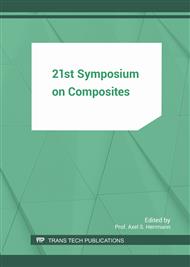[1]
Z. Li, S. Wu, Z. Zhao, L. Xu, Influence of surface properties on the interfacial adhesion in carbon fiber/epoxy composites, Surface and Interface Analysis 46 (2014) 16–23.
DOI: 10.1002/sia.5340
Google Scholar
[2]
X. Qian, X. Wang, Q. Ouyang, Y. Chen, Q. Yan, Effect of ammonium-salt solutions on the surface properties of carbon fibers in electrochemical anodic oxidation, Applied Surface Science 259 (2012) 238–244.
DOI: 10.1016/j.apsusc.2012.07.025
Google Scholar
[3]
J. Liu, Y. Tian, Y. Chen, J. Liang, Interfacial and mechanical properties of carbon fibers modified by electrochemical oxidation in (NH4HCO3)/(NH4)2C2O4·H2O aqueous compound solution, Applied Surface Science 256 (2010) 6199–6204.
DOI: 10.1016/j.apsusc.2010.03.141
Google Scholar
[4]
D.A. Waldman, Y.L. Zou, A.N. Netravali, Ethylene/ ammonia plasma polymer deposition for controlled adhesion of graphite fibers to PEEK, Journal of Adhesion Science and Technology 9 (1995) 1475–1503.
DOI: 10.1163/156856195x00149
Google Scholar
[5]
Y. Xie, P.M.A. Sherwood, X-ray photoelectron-spectroscopic studies of carbon fiber surfaces. 11. Differences in the surface chemistry and bulk structure of different carbon fibers based on poly(acrylonitrile) and pitch and comparison with various graphite samples, Chemistry of Materials 2 (1990).
DOI: 10.1021/cm00009a020
Google Scholar
[6]
M.R. Alexander, F.R. Jones, Effect of electrolytic oxidation on the surface chemistry of type a carbon fibres—Part I, X-ray photoelectron spectroscopy, Carbon 32 (1994) 785–794.
DOI: 10.1016/0008-6223(94)90034-5
Google Scholar
[7]
X. Qian, L. Chen, J. Huang, W. Wang, J. Guan, Effect of carbon fiber surface chemistry on the interfacial properties of carbon fibers / epoxy resin composites, Journal of Reinforced Plastics and Composites 32 (2013) 393–401.
DOI: 10.1177/0731684412468369
Google Scholar
[8]
M.R. Alexander, F.R. Jones, Effect of electrolytic oxidation upon the surface chemistry of type a carbon fibres: III. Chemical state, source and location of surface nitrogen, Carbon 34 (1996) 1093–1102.
DOI: 10.1016/0008-6223(96)00061-9
Google Scholar
[9]
J. Moosburger-Will, J. Jäger, J. Strauch, M. Bauer, S. Strobl, F. Linscheid, S. Horn, Interphase formation and fiber matrix adhesion in carbon fiber reinforced epoxy resin: Influence of carbon fiber surface chemistry, Composite Interfaces (2017).
DOI: 10.1080/09276440.2017.1267513
Google Scholar
[10]
E. Desimoni, G.I. Casella, A. Morone, A.M. Salvi, XPS Determination of Oxygen-containing Functional Groups on Carbon-fibre Surfaces and the Cleaning of These Surfaces, Surface and Interface Analysis 15 (1990) 627–634.
DOI: 10.1002/sia.740151011
Google Scholar


